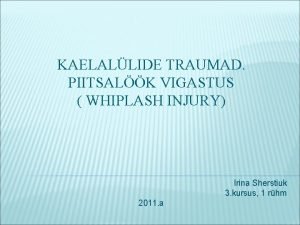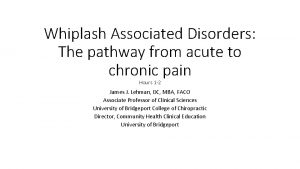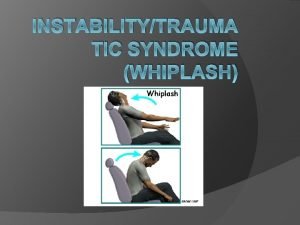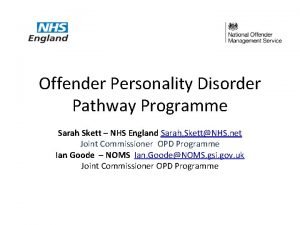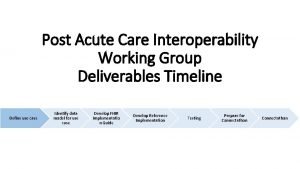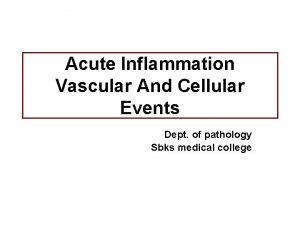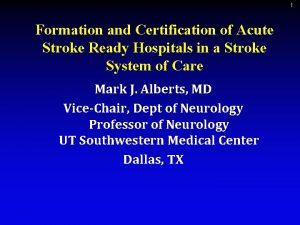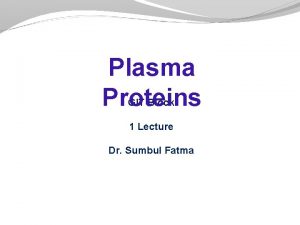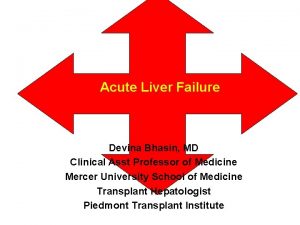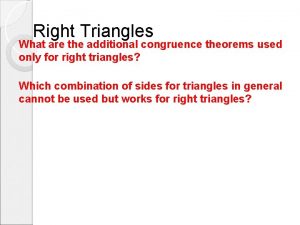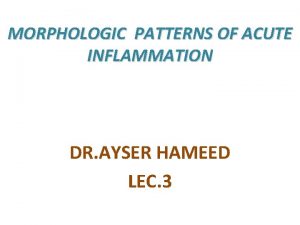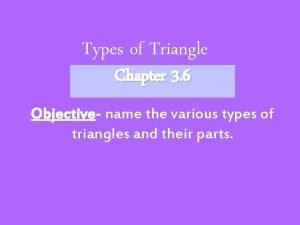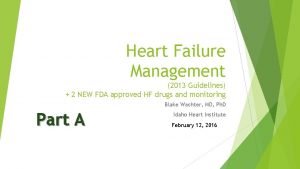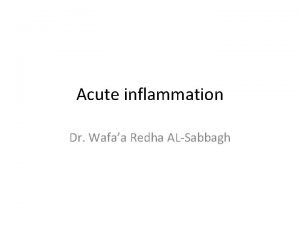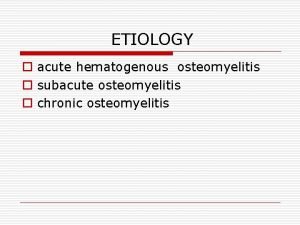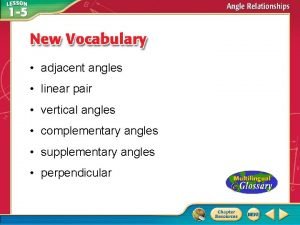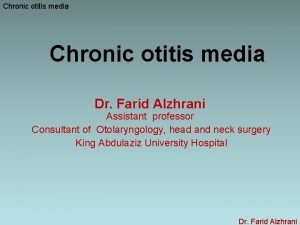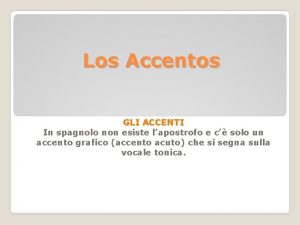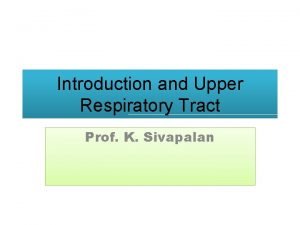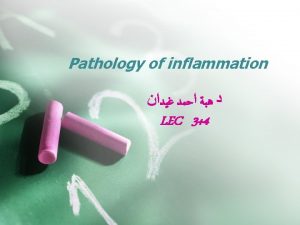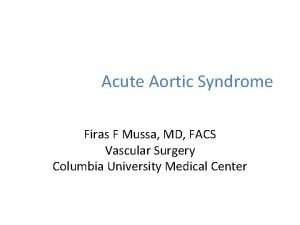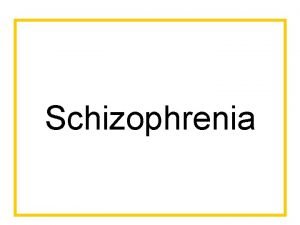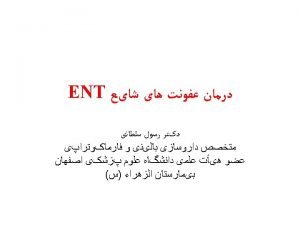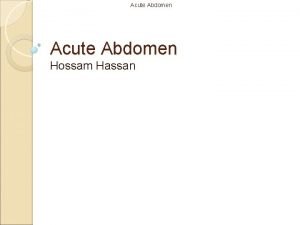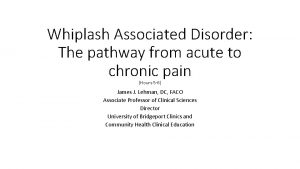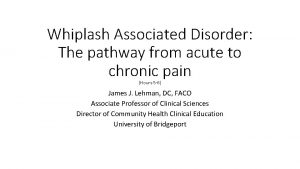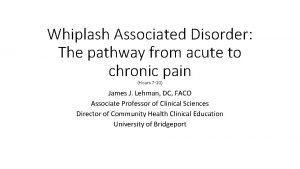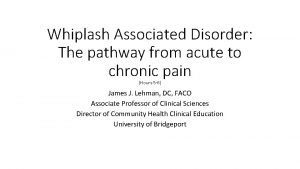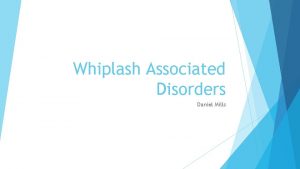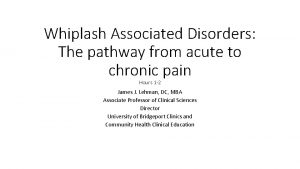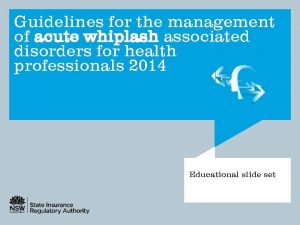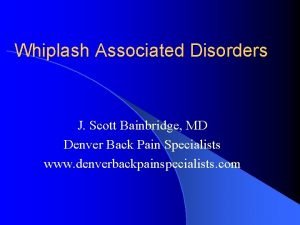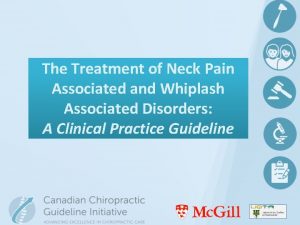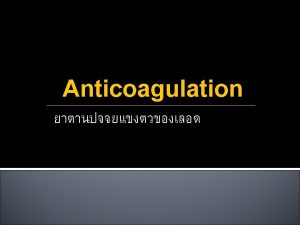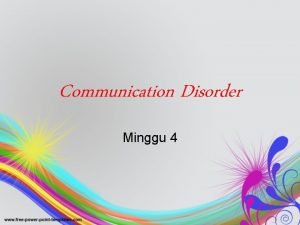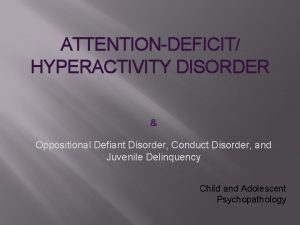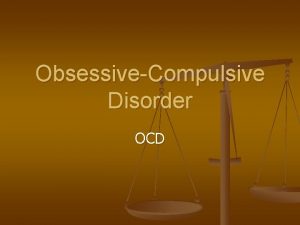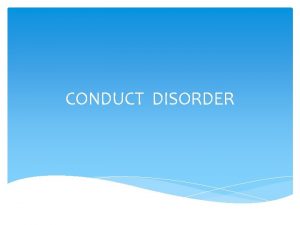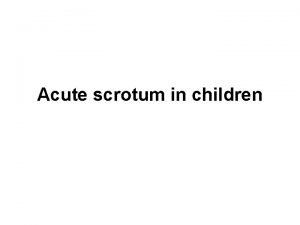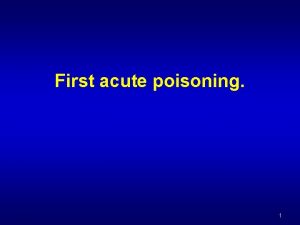Whiplash Associated Disorder The pathway from acute to








































































- Slides: 72

Whiplash Associated Disorder: The pathway from acute to chronic pain (Hours 3 -4) James J. Lehman, DC, FACO Associate Professor of Clinical Sciences Director of Community Health Clinical Education University of Bridgeport

Learning Objectives • Able to evaluate and perform a differential diagnosis of a whiplash type injury patient. • Acute whiplash injury (G 89. 11) (Acute pain due to trauma) • Post‐traumatic chronic pain syndrome (G 89. 21) • Post‐traumatic, high‐impact chronic pain (G 89. 21)

Recommendations prior to treating patients with whiplash injuries. Discover mechanism of injury Determine history of neck pain prior to whiplash injury Reveal pain severity with Numerical Pain Rating Scale (NPRS) Identify the injured tissues and pain generators Understand biopsychosocial factors Perform differential diagnosis Determine a reasonable prognosis Offer appropriate treatment with the use of a team of health care providers • Avoid nocebo effect and promote placebo effect… • •

Diagnosis is the key to successful treatment! Richard C. Ackerman, DC, FACO

Is the Whiplash Type Injury in a Chronic or Acute State?

How Do You Grade this Injury?

How Do You Determine if the Patient Will Develop a Chronic Pain Condition?

Patient Presentation • 33 year‐old female, self‐employed lawyer with two associates • She is properly insured with disability, health insurance and med‐pay • Rear‐ended 7 days prior to initial encounter in your office • Denies prior neck injuries or neck pain • Chief concern of neck stiffness and aching in the lower cervical and upper thoracic spine. “My neck is stiff and it hurts. ” • Able to work but distracted because of aching discomfort later in the work day

Differential Diagnosis Process • Intake form with pertinent data regarding injury • Medical records from ER or other providers • Neck Disability Index (NDI) • Patient interview or history taking • Create list of potential diagnoses • Physical examination • Rule‐in and rule‐out diagnoses • Working diagnosis (es)

Pathoanatomical Lesions in the Whiplash Injury 1. 2. 3. 4. 5. 6. Cervical Facet joints (Zygapophyseal Joints) Dorsal Root Ganglion (DRG) and Nerve Roots Cervical Ligaments Intervertebral Disc Injuries Muscle Injuries Fractures/Dislocations

Whiplash Injury Symptoms • Pain, • dizziness, • visual and auditory disturbances, • temporomandibular joint dysfunction, • photophobia, • dysphonia, • dysphagia, • fatigue, • cognitive difficulties such as concentration and memory loss, anxiety, insomnia, and depression (3)

Diagnosis and prognosis are the keys to successful treatment of whiplash associated disorder.

Subjective Data • Elicit a patient history and record the subjective findings in order to list potential diagnoses and use objective testing to rule‐in and rule‐out potential conditions.

Post-Whiplash Type Injury Interview • Intake form to cover all injury data (MVI, Slip and fall, lifting, etc. ), past medical history, NDI, etc. • Medical records including ER • Focused L‐T acronym • Chief concern • Open‐end questions • Closed‐end questions

Focused Interview or History Taking Process Using an Acronym • Location of pain/injury • Mechanism of injury • New injury/condition • Old injury/condition • Palliative/Provocative • Quality of pain • Radiations/Referred pain • Severity • Timing and Treatment

Subjective Data Identify the Pain Generating Tissue • Location of pain • Use finger point test • Palpate to confirm the pain generating tissue and specific location • Example: • Pain with palpation at right C 1‐ 3 posterior cervical muscles, facet capsules and the ligamentum nuchae

Subjective Data Be Specific • Location of pain • Right posterior upper cervical spine C 1‐ 3 • Ligamentum nuchae C 1‐ 3 Potential tissues injured and painful Cervical muscles (Strain) Capsular ligaments and ligamentum nuchae (Sprain) Osseous tissues (Fracture)

List of Potential Diagnoses Based on Subjective Data • Cervical strain • Cervical sprain • Cervical dislocation • Cervical fracture

Persistent Pain: A Chronic Illness • Acute pain usually goes away after an injury or illness resolves. But when pain persists for months or even years, long after whatever started the pain has gone or because the injury continues, it becomes a chronic condition and illness in its own right. • A Call to Revolutionize Chronic Pain Care in America: An Opportunity in Health Care Reform. The Mayday Fund. November 4, 2009. Amended March 4, 2010.

List of Potential Diagnoses Based on Subjective Data • Are these potential diagnoses acute or chronic? • Cervical strain • Cervical sprain • Cervical dislocation • Cervical fracture

Grading of Spinal Injury • Is this whiplash type injury an acute, mild, moderate, or severe soft or hard tissue injury to the cervical spine? • Can you describe the injuries?

Description of Tissue Injuries • Odontoid process fracture. The small fragment is rotated anteriorly and superiorly. • Portions of the ruptured cruciate ligament and of the rectorial membrane are entrapped in the wide fracture gap. • The apical ligament is avulsed. Only the dura is intact. • In addition in this specimen, uncovertebral and facet joint injuries as well as several disc avulsions (cartilaginous endplate separations) were found.

Soft Tissue Injury Grading • Grade 1 sprain of ligament/joint (Mild) • Overstretch or tear up to 5% • Grade 2 sprain of ligament/joint (Moderate) • Tear up to 50% • Grade 3 sprain of ligament/joint (Severe) • Rupture or complete 100% tear • Grade 4 sprain of ligament/joint/bone (Avulsion) • Complete tear with avulsion of bone

Soft Tissue Injury Grading • Grade 1 strain of muscle/tendon (Mild) • Overstretch or tear up to 5% • Grade 2 strain of muscle/tendon (Moderate) • Tear up to 50% • Grade 3 strain of muscle/tendon (Severe) • Rupture or complete 100% tear • Grade 4 strain of muscle/tendon/bone (Avulsion) • Complete tear with avulsion of bone

Case One = WAD I • Patient presents with neck complaints including stiffness or tenderness in the neck regions and no physical signs of injury. • Spitzer WO, Skovron ML, Salmi LR, et al. Scientific monograph of the Quebec Task Force on Whiplash‐Associated Disorders: redefining “whiplash” and its management. Spine. 1995; 20: 1 S– 73 S. • Most likely diagnosis is acute, mild cervical strain • Prognosis is good • Spontaneous recovery within 2‐ 3 weeks is common.

Case Two: WAD II • Patient presents with neck complaints including stiffness or tenderness, and some physical signs of injury, such as point tenderness or trouble turning the head. • Acute, moderate cervical sprain/strain is most likely DX • Prognosis is difficult to predict • Current management does not appear to lessen transition from acute to chronic pain status • Physical and psychological impairment poorly addressed by treatments predictive of poor recovery

Case Three: WAD III • Patient presents with neck complaints including stiffness or tenderness and neurological signs of injury such as deep tendon reflex or motor deficits. • Acute, moderate sprain/strain with resultant cervical radiculopathy • Current management does not appear to lessen transition from acute to chronic pain status • Physical and psychological impairment poorly addressed by treatments predictive of poor recovery

Case Four: WAD IV • Patient presents with neck complaints with a fracture or dislocation of the cervical spine.

List of Potential Diagnoses Based on Subjective Data • Are these potential diagnoses mild, moderate or severe? • Cervical strain • Cervical sprain • Cervical dislocation • Cervical fracture

Objective Data Ruling-in and Ruling-out Diagnoses • Observation • Palpation • Range of motion • Orthopedic testing • Neurological testing • Laboratory

Objective Data Observation • Appearance • • Stated age Well‐nourished Well‐developed Distinguishing findings • Posture • Antalgic • Erect • Scoliosis (functional or structural) • Gait • Smooth or limping

Objective Data Observation of Posture • What do you see with this young patient? • Does she have scoliosis? • If yes, is it structural or functional? • What could be the cause (s) of this postural deviation?

Objective Data Postural Evaluation • Adam’s positon • Increased dorsal rib hump or increased curvature indicates a structural scoliosis • Reduction of spinal curvature indicates a functional scoliosis • What could be a cause (s) of functional scoliosis?

Objective Data Long Sit Testing


Objective Data Palpation (Flat/Pinching/Static) • Signs of inflammation • • Dolar Rubor Calor Tumor Provocative or pain producing • Painful ligaments • Painful, nodules in muscle • Painful muscles

Palpation Cervicogenic Headaches Neurogenic • Occipital neuralgias • Greater Occipital (2 nd Cervical) • Third Occipital

Cervicogenic Headaches Neurogenic • Differentiate Cranial and Occipital neuralgias

Objective Data Range of Motion (ROM) • Active • First ROM • General findings of pain and restriction or full ROM without pain • Passive • Pain and restriction indicates ligament and/or joint injury (Sprain) • Resistive • Pain and restriction indicates muscle and/or tendon injury (Strain)

L’Hermitte’s Sign Spinal Cord Compression Pain • Stabbing or lightning‐like pain shooting down the spine and any combination of the extremities • Active or passive flexion or extension of the cervical spine

Objective Data Orthopedic Testing • An orthopedic test is most often a provocative maneuver that reproduces the chief concern pain in order to identify the painful/injured tissue. • An orthopedic test may be positive when palliative. • Describe your findings • Do not list + or – indicators alone • Do not state a diagnosis based upon an orthopedic test alone

Objective Data Orthopedic Testing • Passive compression of the cervical spine in lateral flexion, rotation, and extension produced localized pain at C 5‐ 6 left with radiating pain down the left upper extremity to the thumb and index finger.

Objective Data Cervical Spine Orthopedic Testing • Cervical compression and distraction • Neutral, flexion and extension cervical compression • Active and passive maximum cervical compression with lateral flexion, rotation and extension

Objective Data Orthopedic Testing • Chart the specific findings in order to determine the injured tissue • Cervical compression + does not tell the story or demonstrate objective findings.

Upper Cervical Transverse Ligament Sprain Injuries Sharp Purser Test • Stand to the side of the patient and stabilize the C 2 spinous process using pincer grasp. • Gently apply a posterior translation force from the palm of the hand into the patient's forehead • Assess symptoms for degree of linear translation and/or symptom provocation • Positive test would be reproduction of myelopathic symptoms during forward flexion or displacement during AP movement

Neurological Examination • Mental status • CNS examination • Cranial nerve examination • Three‐part peripheral nerve examination • Deep tendon reflexes • Motor function • Sensory perception

Differentiate Upper Motor vs Lower Motor Neuron Lesions • UMNL • Spastic paralysis • Clonus present • Increased deep tendon reflexes • Pathological reflexes present • Weakness with atrophy absent • LMNL • Flaccid paralysis • Clonus absent • Reduced deep tendon reflexes • Pathological reflexes absent • Weakness with atrophy present








Neuromusculoskeletal Examination Videos Timothy Conwell, DC, FACO • Central Nervous System examination • https: //www. youtube. com/watch? v=k. ZOcz 0 cz. Ws 4 • Peripheral Nervous System examination https: //www. youtube. com/watch? v=I 7 YF 4 v. CBis. Q • Spine and paraspinal examination https: //www. youtube. com/watch? v=Heg. Byhhb 8 s. I

Diagnosis and prognosis are the keys to successful treatment of whiplash associated disorder.

Prognosis Post Whiplash Type Injury End of Healing Stage • Sprained ligaments heal with a cheaper grade of mesenchymal tissue = cicatrix or scar. • A scar left by the formation of new connective tissue over a healing sore or wound. • Scar tissue is avascular, pale, contracted, and firm after the earlier phase of soft tissue healing.


Prognosis Post Whiplash Type Injury • Post‐traumatic chronic pain syndrome • Chronic myofascial pain syndrome • Degenerative joint and disc disease or “Cervical Spondylosis”

Cervical Spine Video Fluoroscopy Laxity of Cervical Ligaments • https: //www. bing. com/videos/s earch? q=dmx+cervical+joint+mo tion+study&&view=detail&mid= 893 FE 46450 F 84 E 6 A 1994893 FE 4 6450 F 84 E 6 A 1994&&FORM=VRD GAR

Post Whiplash Cervical Spine Fracture • https: //www. bing. com/videos/s earch? q=dmx+cervical+joint+mo tion+study&&view=detail&mid= D 1 F 938 F 5 AA 32 C 79 EB 8 A 5 D 1 F 93 8 F 5 AA 32 C 79 EB 8 A 5&&FORM=VD RVRV

Post Whiplash Injury to the Cervical Spine with Arm Pain MRI Exam • https: //www. bing. com/videos/s earch? q=dmx+cervical+joint+mo tion+study&&view=detail&mid= 9737 C 11761 F 38 B 2 E 00 BE 9737 C 1 1761 F 38 B 2 E 00 BE&rvsmid=D 1 F 9 38 F 5 AA 32 C 79 EB 8 A 5 D 1 F 938 F 5 A A 32 C 79 EB 8 A 5&FORM=VDQVAP

Diagnosis, Prognosis and Treatment Recommendations • How you advise your patient of the diagnosis, prognosis and treatment may affect the patient response.

Placebo versus Nocebo Effects • The “placebo” effect is related to the perceptions and expectations of the patient • If the intervention is viewed as helpful, it can heal, but, if it is viewed as harmful, it can cause negative effects, which is known as the “nocebo” effect.

Recommendations prior to treating patients with whiplash injuries. Discover mechanism of injury Determine history of neck pain prior to whiplash injury Reveal pain severity with Numerical Pain Rating Scale (NPRS) Identify the injured tissues and pain generators Understand biopsychosocial factors (Neck Disability Index [NDI]) Perform differential diagnosis Determine a reasonable prognosis Offer appropriate treatment with the use of a team of health care providers • Avoid nocebo effect and promote placebo effect… • •

Patient Presentation • 33 year‐old female, self‐employed lawyer with two associates • She is properly insured with disability, health insurance and med‐pay • Rear‐ended 7 days prior to initial encounter in your office • Denies prior neck injuries or neck pain • Chief concern of neck stiffness and aching in the lower cervical and upper thoracic spine • Able to work but distracted because of aching discomfort later in the work day

Engaged Learning Task (30 minutes) • Form groups of 3‐ 4 • Select a spokesperson who will provide a brief presentation • Determine appropriate evaluation including history and physical examination • Perform differential diagnosis • Recommend treatment plan • Give prognosis • Chart with SOAP process

Spokesperson Will Present and Defend Your Work • Another group will be selected to question the presentation. • Do you agree with evaluation? • Do you agree with list of potential diagnoses and working diagnosis? • Do you agree with the prognosis and treatment recommendations?

Recommendations prior to treating patients with whiplash injuries. Discover mechanism of injury Determine history of neck pain prior to whiplash injury Reveal pain severity with Numerical Pain Rating Scale (NPRS) Identify the injured tissues and pain generators Understand biopsychosocial factors Perform differential diagnosis Determine a reasonable prognosis Offer appropriate treatment with the use of a team of health care providers • Avoid nocebo effect and promote placebo effect… • •

References 1. Barnsley L, Lord S, Bogduk N. Whiplash injury. Pain. 1994; 58: 283– 307. 2. Spitzer WO, Skovron ML, Salmi LR, et al. Scientific monograph of the Quebec Task Force on Whiplash‐Associated Disorders: redefining “whiplash” and its management. Spine. 1995; 20: 1 S– 73 S. 3. Elliot JM, et al. Characterization of Acute and Chronic Whiplash‐Associated Disorders. Journal of Orthopaedic & Sports Physical Therapy, 2009, Volume: 39 Issue: 5 Pages: 312‐ 323. 4. Jouko Kivioja, Irene Jensen, and Urban Lindgren. Neither the WAD‐classification nor the Quebec Task Force follow‐up regimen seems to be important for the outcome after a whiplash injury. A prospective study on 186 consecutive patients. Eur Spine J. 2008 Jul; 17(7): 930– 935. Hasue M. Pain and the nerve root. An interdisciplinary approach. Spine. 1993; 18: 2053‐ 2058. 6. Jansen J, Bardosi A, Hildebrandt J, Lucke A. Cervicogenic, hemicranial attacks associated with vascular irritation or compression of the cervical nerve root C 2. Clinical manifestations and morphological findings. Pain. 1989; 39: 203‐ 212. 7. Kaale BR, Krakenes J, Albrektsen G, Wester K. Head position and impact direction in whiplash injuries: associations with MRI‐verified lesions of ligaments and membranes in the upper cervical spine. J Neurotrauma. 2005; 22: 1294‐ 1302. 8. Kaale BR, Krakenes J, Albrektsen G, Wester K. Whiplash‐associated disorders impairment rating: neck disability index score according to severity of MRI findings of ligaments and membranes in the upper cervical spine. J Neurotrauma. 2005; 22: 466‐ 475. 9. Jonsson H, Jr, Bring G, Rauschning W, Sahlstedt B. Hidden cervical spine injuries in traffic accident victims with skull fractures. J Spinal Disord. 1991; 4: 251. 10. Pettersson K, Hildingsson C, Toolanen G, Fagerlund M, Bjornebrink J. Disc pathology after whiplash injury. A prospective magnetic resonance imaging and clinical investigation. Spine. 1997; 22: 283‐ 287; discussion 288. 263.

References 11. Borchgrevink GE, Kaasa A, Mc. Donagh D, Stiles TC, Haraldseth O, Lereim I. Acute treatment of whiplash neck sprain injuries. A randomized trial of treatment during the first 14 days after a car accident. Spine. 1998; 23: 25‐ 31. 12. Kasch H, Qerama E, Bach FW, Jensen TS. Reduced cold pressor pain tolerance in non‐recovered whiplash patients: a 1‐year prospective study. Eur J Pain. 2005; 9: 561‐ 569. 13. Tjell, C. and U. Rosenhall (1998). “Smooth pursuit neck torsion test: a specific test for cervical dizziness. ” Otology & Neurotology 19(1): 76. 14. Treleaven, J. , G. Jull, et al. (2003). “Dizziness and unsteadiness following whiplash injury: characteristic features and relationship with cervical joint position error. ” Journal of Rehabilitation Medicine 35(1): 36‐ 43. 15. Treleaven, J. , G. Jull, et al. (2005). “Smooth pursuit neck torsion test in whiplash‐associated disorders: relationship to self‐reports of neck pain and disability, dizziness and anxiety. ” Journal of Rehabilitation Medicine 37(4): 219‐ 223. 16. Treleaven, J. , G. Jull, et al. (2005). “Standing balance in persistent whiplash: a comparison between subjects with and without dizziness. ” Journal of Rehabilitation Medicine 37(4): 224‐ 229. 17. Jull, G. , D. Falla, et al. (2007). “Retraining cervical joint position sense: The effect of two exercise regimes. ” Journal of Orthopaedic Research 25(3): 404‐ 412. 18. Treleaven J, Jull G, Sterling M. Dizziness and unsteadiness following whiplash injury: characteristic features and relationship with cervical joint position error. J Rehabil Med. 2003 Jan; 35(1): 36‐‐‐ 43. 19. Sterling M, et al. Sensory hypersensitivity occurs soon after whiplash injury and is associated with poor recovery Pain 104 (2003) 509‐ 517. 20. Adams JH, Doyle D, Ford I, Gennarelli TA, Graham DI, Mc. Lellan DR. Diffuse axonal injury in head injury: definition, diagnosis and grading. Histopathology. 1989; 15: 49– 59. 21. Walton DM, & Elliott JM. An Integrated Model of Chronic Whiplash‐Associated Disorder. Journal of Orthopedic and Sports Physical Therapy. July 2017, Volume 47, Number 7.

 Whiplash injury
Whiplash injury Whiplash symptoms
Whiplash symptoms Whiplash tic
Whiplash tic Post traumatic stress disorder
Post traumatic stress disorder Offender personality disorder pathway
Offender personality disorder pathway Malingering disorder
Malingering disorder Hình ảnh bộ gõ cơ thể búng tay
Hình ảnh bộ gõ cơ thể búng tay Cái miệng nó xinh thế
Cái miệng nó xinh thế Mật thư anh em như thể tay chân
Mật thư anh em như thể tay chân Tư thế ngồi viết
Tư thế ngồi viết Giọng cùng tên là
Giọng cùng tên là Chó sói
Chó sói Thẻ vin
Thẻ vin Thể thơ truyền thống
Thể thơ truyền thống Các châu lục và đại dương trên thế giới
Các châu lục và đại dương trên thế giới Hổ sinh sản vào mùa nào
Hổ sinh sản vào mùa nào Từ ngữ thể hiện lòng nhân hậu
Từ ngữ thể hiện lòng nhân hậu Thế nào là hệ số cao nhất
Thế nào là hệ số cao nhất Diễn thế sinh thái là
Diễn thế sinh thái là Lp html
Lp html Vẽ hình chiếu vuông góc của vật thể sau
Vẽ hình chiếu vuông góc của vật thể sau Làm thế nào để 102-1=99
Làm thế nào để 102-1=99 Lời thề hippocrates
Lời thề hippocrates Chụp tư thế worms-breton
Chụp tư thế worms-breton đại từ thay thế
đại từ thay thế Quá trình desamine hóa có thể tạo ra
Quá trình desamine hóa có thể tạo ra Công của trọng lực
Công của trọng lực Khi nào hổ mẹ dạy hổ con săn mồi
Khi nào hổ mẹ dạy hổ con săn mồi Thế nào là mạng điện lắp đặt kiểu nổi
Thế nào là mạng điện lắp đặt kiểu nổi Dot
Dot Bổ thể
Bổ thể Vẽ hình chiếu đứng bằng cạnh của vật thể
Vẽ hình chiếu đứng bằng cạnh của vật thể Thế nào là sự mỏi cơ
Thế nào là sự mỏi cơ độ dài liên kết
độ dài liên kết Thiếu nhi thế giới liên hoan
Thiếu nhi thế giới liên hoan Alleluia hat len nguoi oi
Alleluia hat len nguoi oi điện thế nghỉ
điện thế nghỉ Một số thể thơ truyền thống
Một số thể thơ truyền thống Trời xanh đây là của chúng ta thể thơ
Trời xanh đây là của chúng ta thể thơ Thế nào là số nguyên tố
Thế nào là số nguyên tố đặc điểm cơ thể của người tối cổ
đặc điểm cơ thể của người tối cổ Tỉ lệ cơ thể trẻ em
Tỉ lệ cơ thể trẻ em Fecboak
Fecboak Các châu lục và đại dương trên thế giới
Các châu lục và đại dương trên thế giới ưu thế lai là gì
ưu thế lai là gì Hệ hô hấp
Hệ hô hấp Tư thế ngồi viết
Tư thế ngồi viết Môn thể thao bắt đầu bằng từ chạy
Môn thể thao bắt đầu bằng từ chạy Interoperability in the post-acute space
Interoperability in the post-acute space Vascular and cellular events of acute inflammation
Vascular and cellular events of acute inflammation Acute stroke ready certification
Acute stroke ready certification What is a negative acute phase protein
What is a negative acute phase protein Acute liver failure criteria
Acute liver failure criteria Classification of periradicular lesions
Classification of periradicular lesions What is ll congruence theorem
What is ll congruence theorem Morphologic patterns of acute inflammation
Morphologic patterns of acute inflammation Acute triangle
Acute triangle 4th stage renal failure
4th stage renal failure Acute mi
Acute mi Dr el sabbagh
Dr el sabbagh Chronic blood loss
Chronic blood loss Acute subacute chronic
Acute subacute chronic Name an angle or angle pair that satisfies each condition
Name an angle or angle pair that satisfies each condition Site:slidetodoc.com
Site:slidetodoc.com Alfabeto spagnolo accenti
Alfabeto spagnolo accenti Protective reflexes
Protective reflexes Acute and chronic inflammation difference
Acute and chronic inflammation difference Morphology pattern of acute inflammation
Morphology pattern of acute inflammation Facs
Facs Schizophrenia
Schizophrenia Laryngitis
Laryngitis Acute triangle
Acute triangle Acute abdomen treatment
Acute abdomen treatment
